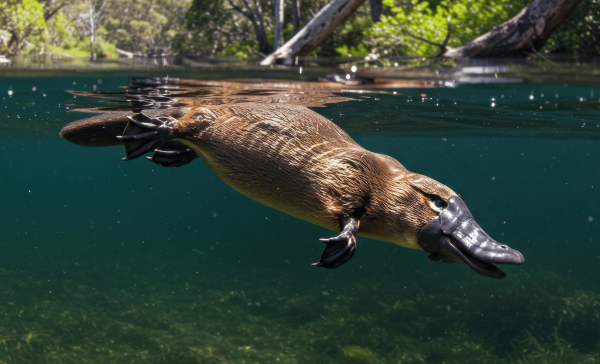
“ Do you think God gets stoned? I think so… look at the platypus.” – Robin Williams
The Platypus. Also known as the “watermole” or the “duckmole”, is a fascinating and unique animal in anatomy. The platypus is native to Eastern Australia and Tasmania. It is an egg laying mammal and its biology is a mix of mammalian, reptilian, and bird-like traits such as a duck-like bill, webbed feet, venomous spurs, and the ability to detect electrical signals underwater. The platypus is now a recognized symbol of evolutionary innovations. In this article, we will tour the complex biology of the platypus.
Here’s a breakdown.
- The Nervous system: The Platypus nervous system is adapted for its aquatic lifestyle and it is highly specialized. The bill of the platypus contains electroreceptors that allow the platypus to detect electrical fields and vibrations from their prey underwater. This sensation is crucial for the survival of the platypus considering that they close their eyes, ears and nostrils while swimming and hunting underwater.
- Venom: As for venom, only the male platypus have venomous spurs that are on their hind legs and are specifically only used during mating season to compete with other male platypus. Thankfully, the venom from a platypus isn’t lethal to humans but it can cause extreme pain and swelling to the body. With research, it is proven that the platypus share common traits to snakes and other reptiles due to similar environments.
- Reproduction: Interestingly enough, the platypus is the only mammal that has the ability to lay eggs like a reptile, making the platypus a monotreme. Females typically lay up to 1-3 eggs which they sit on by curling their bodies around the eggs for up to 10 days. Once the eggs have hatched, the babies which are also called “puggles” are then fed with the mother”s milk that is produced from mammary glands. The milk is released through the mother’s pores in the skin since the platypuses do not have nipples like other animals do. The baby platypus usually remains in the burrow for about 3 to 4 months before emerging.
- Genetics: With the platypus’ unique and complex mix of genetic makeup, unlike most mammals, the platypus DNA consists of 10 sex chromosomes and also shares genetic features with some reptiles, considering that they lay eggs and have venomous spurs. The platypuses’ genes highlight the evolutionary connections between reptiles and mammals.
- Physical traits: By observing its traits,we can see that the platypus has a duck-like bill, webbed feet, a flat tail, and thick waterproof fur. Adult platypuses do not have any teeth, so instead they grind their food with keratin-covered pads in their bills. Their body is designed for swimming, considering the webbed feet, their limbs are positioned in a way for the platypus to paddle efficiently through the water.
- Habitat and Behavior: When it comes to the platypus habitat and behavior, surprisingly enough the platypus is nocturnal and spends most of its time in freshwater rivers and lakes in eastern Australia and Tasmania. Platypuses are not only excellent swimmers but they also tend to rest in burrows that are dug into riverbanks under water for their prey. Platypus usually hunt insects, larvae and small aquatic animals such as fish. Platypus can also submerge underwater for about 40 seconds and mainly rely on the electroreceptors in their bills to find food.
Regardless of the complex biology of the platypus, it sure is a remarkable and unique creature that showcases the mix of traits from mammals, birds, and reptiles. By its ability to lay eggs, electro-sensitive bill and venomous spurs, the platypus shines a light on the diversity of evolutionary adaptations. Studying the insane biology of these animals allows insight to not only its survival, but it also allows us to have a better understanding and knowledge of their biodiversity.
